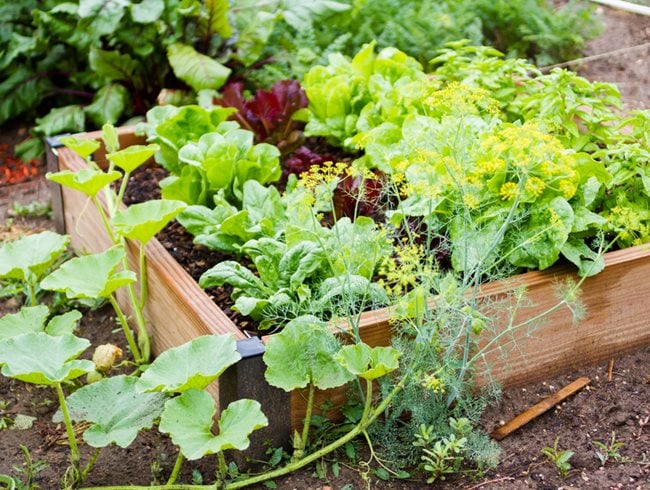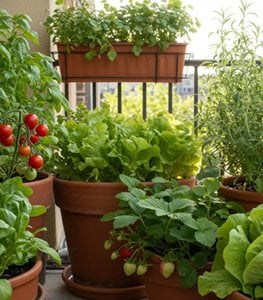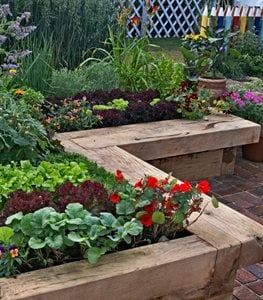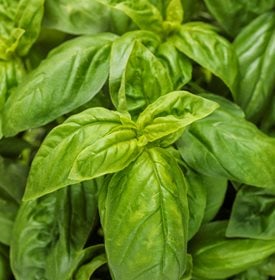Growing Vegetables in Small Spaces
Every square inch matters in a small vegetable garden. Here are practical tips for increasing your bounty.Is your garden bed a twin size versus a king? Or maybe you have no land at all, and only a tiny balcony or patio. No problem. As long as you can find a sunny location, either on the ground or in mid-air, you can satisfy your appetite for freshly picked produce.

Even in a small 4-foot by 4-foot bed like this, you can grow plenty of vegetables. Photo by: Arina P Habich | Shutterstock.
“Almost everyone has access to more space than they realize. It just takes a little creative thinking to see it,” says Andrea Bellamy, in her book Small-Space Vegetable Gardens. A rooftop, alleyway, front porch, and even a fire escape are all viable spots for growing vegetables. The keys to success are careful planning and making the most of what you’ve got.
MAXIMIZE YOUR SPACE
Grow vegetables in containers
If growing in the ground is not an option due to space limitations, poor soil, or lack of sun, containers are great alternatives. When growing edibles in pots, choose patio or dwarf varieties and shallow-rooted plants such as lettuce, radishes, garlic, and leeks. For containers, you can use almost anything that holds soil—from fabric grow bags to old metal wash buckets—as long as you provide good drainage, says Bellamy. Remember that container plants need more water than those in the ground, it’s best not to let them completely dry out. Also be sure to fertilize your containers during the growing season, using an organic fertilizer such as liquid kelp.
Learn more about growing vegetables in pots.
Grow vegetables in raised beds
Raised garden beds are also a great option—if you have a level foundation on which to build them. Compared with in-ground beds, they offer the advantages of easier access, better drainage, and faster warming of the soil in the spring. “Digging and tilling beds in the ground is great, but it can take a few years to build up really good soil. Raised beds filled with a mix of good soil and compost will get beginners off to a good start. Even a bed as small as 4x4 feet will hold a lot of vegetables and be manageable,” says Susie Middleton, an avid kitchen gardener and the author of numerous cookbooks including, Simple Green Suppers: A Fresh Strategy for One-Dish Vegetarian Meals.
To learn more about materials and layouts for raised beds, see How to Lay Out and Build Raised Bed Gardens.
Grow vegetables vertically
If you want to plant vining vegetables such as pole beans, cucumbers, and squash, give them something for their tendrils to grab on to like a trellis, fence, or netting. Gardening up not only saves space, it also creates structure and visual interest. “I like to plant cucumbers against the garden fence or up a trellis to save space; each plant only needs about a foot of space in the garden,” says Middleton.
Trellises come in countless shapes, styles, and materials. But you can easily make your own using simple bamboo poles secured at the top to form a tepee shape. If you have space on a sunny exterior wall, Bellamy recommends growing herbs and shallow-rooted vegetables in wall-mounted planters or modular green wall systems.
For more vertical gardening ideas, see Arbors, Trellises, and the Edible Garden
Create an edible landscape
Edible landscaping is a creative and attractive solution to growing vegetables in a front yard or other conspicuous location. Try mixing ornamental vegetables and herbs into the perennial garden or tuck them into containers. They can also be attractive on their own, especially if you combine various colors and textures.
For ideas, see Aiming for Aesthetic Edibles.
HOW TO CHOOSE THE BEST VEGETABLES FOR SMALL GARDENS
Be productive
When you only have limited garden space to work with, choose plants that will give you big yields in a small area. Many vegetables and herbs have compact cultivars that are container friendly and ideal for small gardens. (See below for 12 great space-saving edibles to grow.)
Make priorities
In a small garden, you have little room to experiment or plant crops that will go to waste. Make priorities by planting what you love, what’s unique, and what will thrive. Also plant what tastes best freshly picked. “Lettuce meets all my qualifications for a perfect crop,” says Bellamy. “I use a lot of it, and it tastes best straight from the garden. It’s also fast growing, attractive, space efficient, and easy to grow.”
Come back for more
Many types of garden greens will feed you throughout the growing season if you harvest them continuously. These “cut-and-come” vegetables keep on giving by sprouting new leaves when the outer leaves are snipped off. Examples include loose-leaf lettuce, chard, kale, collard greens, mesclun, and escarole. “Lettuce varieties like ‘Salad Bowl’ and ‘Red Salad Bowl’ are great for containers or any small space. Instead of letting the lettuce head up, you can pick the outer leaves continuously,” says Middleton.
12 FRUITS & VEGETABLES FOR SMALL SPACES
PLAN FOR BETTER YIELDS
Keep ‘em coming
Keep your small garden productive throughout the growing season by planting a series of crops in succession in a garden bed or container, starting with cool-season, early-maturing crops in the spring followed by mid-season and late-summer vegetables that will last until fall. “The idea of succession planting is to not let valuable garden space sit idle, and to be ready to plant something new whenever a space opens up,” says Bellamy. The same technique can also be used to extend the growing season for one type of crop, particularly fast-maturing edibles such as radishes and beans. By planting them in two- to three-week intervals they will reach maturity at different times.
Choose good companions
Interplanting is similar in concept to succession planting, except that you maximize yields by pairing up different crops that are good companions and grow at different rates. For example, you can plant sugar snap peas in early spring and plant pole beans among them. By the time the peas are spent, the beans will be ready to take their place.
Succession planting and companion planting and great ways to increase your yield when growing vegetables in a raised bed—the only downside is that they won’t really work in containers.
Stretch the growing season
Vegetable gardens aren’t just for the warm-weather months of May through September. There are many cool-season crops that will thrive in the ground or in containers well into fall, and some will even survive a nip of frost. See these suggestions for 15 fall vegetables.
RELATED:
How to Start a Vegetable Garden
Growing Vegetables in Pots
Arbors, Trellises and the Edible Garden
Spring Greens















